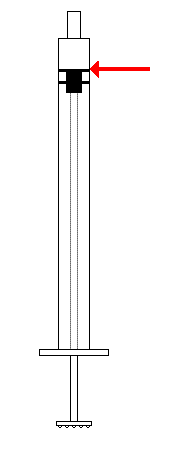Add 4 ml water with a 5 ml syringe to the measuring tube, add 2 drops of the green stuff, then fill the 1 ml syringe with the plastic tip from the large bottle. Filling it means draw the piston so that the part of the black rubber thing that is closest to the tip of the syringe is in line with the 1 ml mark.
Then I putted 0,4 ml into the measuring tube (so that the piston stopped at 0,6 ml mark), swirled it for 10 seconds. Then continued to add one drop at a time swirling the tube for about 1 second between each drop, when the piston was somewhere between the 0,1 ml and 0,2 ml mark I first saw a purple color for a fraction of a second and at 0,1 ml I saw a pink color for a few seconds before turning purple. At 0,08 ml it stayed pink.
EDIT: I did the same thing with the Alkalinity Check Solution just to make sure I wasn't doing anything really wrong. I got the result 7,4 dKH.


